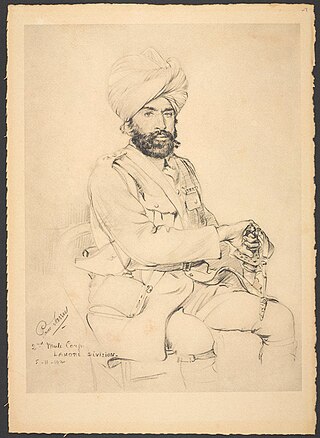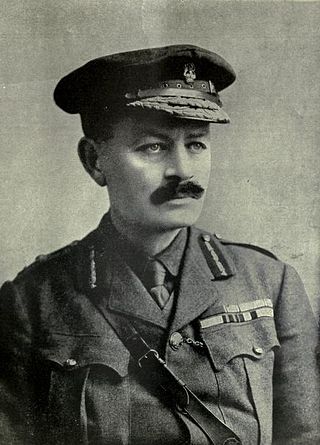
The 7th Infantry Division was an infantry division of the British Army, first established by The Duke of Wellington as part of the Anglo-Portuguese Army for service in the Peninsular War, and was active also during the First World War from 1914 to 1919, and briefly in the Second World War in 1939.

The 47th Division was an infantry division of the British Army, raised in 1908 as part of the Territorial Force.

The 3rd Gorkha Rifles or Third Gorkha Rifles, abbreviated as 3 GR is an Indian Army infantry regiment. It was originally a Gurkha regiment of the British Indian Army formed in 1815. This regiment recruit mainly Magars and Gurung tribes. They were present at a number of actions and wars including the siege of Delhi in 1857 to the First and Second World Wars. After the Partition of India in 1947 the regiment was one of the six Gorkha regiments transferred to the Indian Army as part of the Tripartite Agreement signed between India, Nepal and Britain at the time of Indian independence. Prior to independence, the regiment was known as the 3rd Queen Alexandra's Own Gurkha Rifles. In 1950 the regiment's title was changed to 3rd Gorkha Rifles. Since 1947 the regiment has participated in a number of conflicts including the 1947 and 1971 wars against Pakistan.

The Battle of Neuve Chapelle took place in the First World War in the Artois region of France. The attack was intended to cause a rupture in the German lines, which would then be exploited with a rush to the Aubers Ridge and possibly Lille. A French assault at Vimy Ridge on the Artois plateau was also planned to threaten the road, rail and canal junctions at La Bassée from the south as the British attacked from the north. The British attackers broke through German defences in a salient at the village of Neuve-Chapelle but the success could not be exploited.

Winter operations 1914–1915 is the name given to military operations during the First World War, from 23 November 1914 – 6 February 1915, in the 1921 report of the British government Battles Nomenclature Committee. The operations took place on the part of the Western Front held by the British Expeditionary Force (BEF), in French and Belgian Flanders.

The Indian Army, also called the British Indian Army, was involved in World War I as part of the British Empire. More than one million Indian troops served overseas, of whom more than 60,000 died during the war.
The 39th Garhwal Rifles was an infantry regiment of the British Indian Army.
The 15th Indian Division was an infantry division of the British Indian Army that saw active service in the First World War. It served in the Mesopotamian Campaign on the Euphrates Front throughout its existence. It did not serve in the Second World War, but was reformed at Dehradun in 1964 as part of the post-independence Indian Army.

The 7th (Meerut) Division was an infantry division of the Indian Army and before 1895, the Bengal Army, that saw active service during World War I.

The 3rd (Lahore) Division was an infantry division of the Indian Army and before 1895, the Bengal Army, first organised in 1852. It saw service during World War I as part of the Indian Corps in France before being moved to the Middle East where it fought against troops of the Ottoman Empire.

XLIII (Howitzer) Brigade was a unit of Britain's Royal Field Artillery from 1900 until 1919. After serving in India it returned to the UK, where it underwent several reorganisations. It served with 1st Divisional Artillery on the Western Front during the first two years of World War I, including the Battles of Mons, Ypres, and Loos before being broken up. It reformed as a field gun brigade in home defence in 1917 but was disbanded after the Armistice.
The 17th Indian Division was formed in 1917 from units of the British Indian Army for service in the Mesopotamia Campaign during World War I. After the war, it formed part of the occupation force for Iraq and took part in the Iraq Rebellion in 1920. In August 1923, the division was reduced to a single brigade.
The 18th Indian Division was an infantry division of the British Indian Army that saw active service in the First World War. It took part in the Mesopotamian campaign and formed part of the occupation force for Iraq post-war. The division was not reformed for the Second World War.

The I Indian Corps was an army corps of the British Indian Army in the World War I. It was formed at the outbreak of war under the title Indian Corps from troops sent to the Western Front. The British Indian Army did not have a pre-war corps structure, and it held this title until further corps were created. It was withdrawn from the Western Front in December 1915 and reconstituted as I Indian Corps in Mesopotamia until the end of the war.
This is the order of battle for the First Battle of Ypres fought from 19 October to 22 November 1914 as one of the main engagements of the First World War. It was fought between mixed British Expeditionary Force, French eighth army and armies of the German Empire in northern France and Flanders.

The 59th Division was an infantry division of the British Army during World War I. It was formed in late 1914/early 1915 as a 2nd Line Territorial Force formation raised as a duplicate of the 46th Division. After training in the United Kingdom and saw service in the Easter Rising in April 1916, the division joined the British Expeditionary Force (BEF) on the Western Front in early 1917. It saw action at Ypres and Cambrai, and was almost destroyed during the German Army's Spring Offensive in March 1918. The reconstituted division took part in the final advances of the war.

The Force in Egypt was a British Army formation established in August 1914 to administer garrisoning armed forces in Egypt at the beginning of the First World War. The force had the objective of protecting the Suez Canal and was originally commanded by Major General Julian Byng, but he was replaced by General J. Maxwell, who took command on 8 September 1914. Initially, the main threat to the Suez came from Germany and throughout the early months several of the force's elements were sent to Europe to take part in the fighting on the Western Front. On 5 November 1914, Britain and France declared war on the Ottoman Empire, after which the Force in Egypt faced a direct threat from Ottoman forces, which was realised in February 1915 with a raid on the Suez Canal. This threat remained until 1916 when the British forces went on the offensive.
The Garhwal Brigade was an infantry brigade of the British Indian Army formed in 1902 as a result of the Kitchener Reforms. It was mobilized as 20th (Garhwal) Brigade at the outbreak of the First World War as part of the 7th (Meerut) Division and departed for France. It served on the Western Front until November 1915. It then moved to Egypt where it joined the 10th Indian Division, by now designated as 20th Indian Brigade. It left the division in March 1916 and thereafter served as an independent brigade in the Sinai and Palestine Campaign. It was broken up in 1920.
The 28th Indian Brigade was an infantry brigade of the British Indian Army that saw active service with the Indian Army during the First World War. Formed in October 1914, it defended the Suez Canal in early 1915, ended the Ottoman threat to Aden in July 1915, took part in the Mesopotamian Campaign in 1916 and 1917, before finishing the war in the Sinai and Palestine Campaign. It remained in Palestine until it was broken up in 1920.
The Structure of the Egyptian Expeditionary Force over the course of the First World War is shown below.













